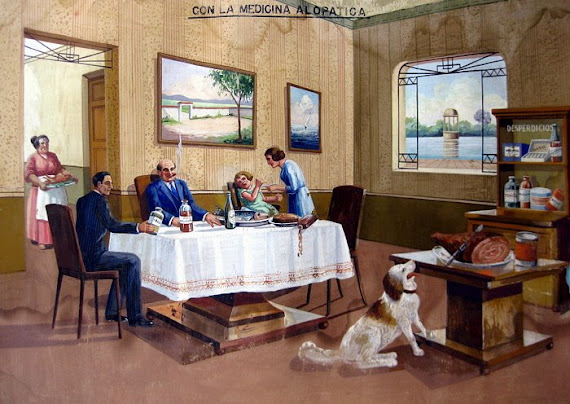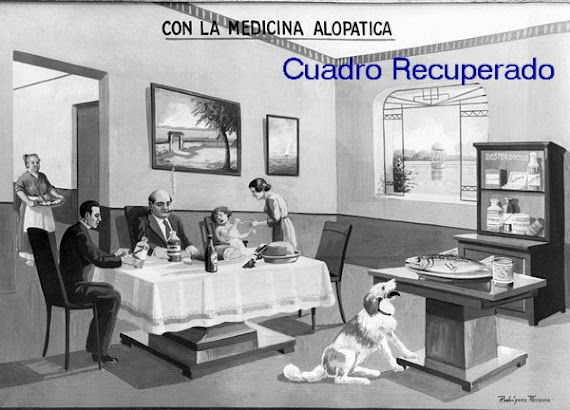
FATHER SEBASTIAN KNEIPP (1821 † 1894) HEALER EXTRAORDINARY
THE AMERICAN NATUROPATHIC ASSOCIATION, Inc GOLDEN JUBILEE CONGRESS NEW YORK 1947 Juli 28 / August 2 1947 Fifth Chapter
There was Preissnitz, the farmer, Schroth the carter, Just the teacher, Kuhne the weaver among others and now we consider the works of Kneipp the Priest.
No man of the profession left a more marked imprint for posterity to ponder than did Father Sebastian Kneipp, who
independently established his own peculiar system o£ water applications.
None of his predecessors was more individual, more rugged or more devout in preaching the gospel of good health.
Kneipp's song of health which heralded his belief is contained in the simple passage:
"All ye waters praise ye the Lord!" And that is what Father Kneipp did in his work. Unselfishly he labored until he was an old man to help suffering humanity He never charged or took a fee. Those numbering into tens of thousands who were helped expressed their gratitude as the spirit moved them and all proceeds went to charity.
To understand the greatness of the man it is necessary that we carry you back to his humble and impoverished parentage.
Sebastian Kneipp was the son of a poor weaver. He was born at Stephansried near Ottobeuren on the seventeenth day of May 1821.
The boy Sebastian early showed signs of eagerness to learn but his parents had not the means to help him. He became a weaver like his father and helped as a good son would until he was 21.
Then the desire to become a priest overpowered him and he left home. From village to village he traveled seeking the aid of priests so as to begin study for the priesthood.
Chaplain Mathias Merkl, of Gronenbach, who was later to become a bishop, became interested in Kneipp after the young man's many fruitless attempts to get help. This patient priest taught Kneipp, Latin and prepared him for High School.
Actual want and long hours of study, caused Kneipp to become rundown and lose strength. He developed consumption, far more a dread condition then than now. Every effort was made to help him. Professor Pezold, of Munich did all possible for him without results.
Kneipp, then in the gymnasium or high school saw his prospects of becoming a priest fast fading away. He was determined to enter the priesthood, but it looked as though death would prevent. He would take matters into his own hands. He sought knowledge on every hand. Nothing seemed to offer any hope, that is, nothing until he came upon a small work, by the first German water Doctor, Dr. Hahn on the curative properties of cold water, which was edited by Dr. Huefland, an old and respected physician. A number of cures by water treatment were recorded in this little volume.
Kneipp was struck with the simplicity of the work. Just the reading of it gave him new hope and courage. He lost no time in putting the instructions into action
His perseverance in applying the measures was rewarded by results. The disease was arrested so he could finally resume his studies for the priesthood and as time went on he grew increasingly better until his health was better than ever before.
So taken was he by his success with water that he recommended the same to others, among the student body. So remarkable were the results that he was lead to continue his recommendations even after he had been elevated to the priesthood.
Keen powers of observation enabled the young student and later priest to make important discoveries. Coupled with his good common sense and practical views he was developing a system of treatments almost without realizing it.
So widespread had his fame become that he was known as the "Priest who heals with water." That jealousies should arise seemed inevitable. He had been warned by the Bishop to confine his ministrations to the soul. But his parish which was composed of many poor farmers often required his attention on the sick, and as he ministered to the spiritual with prayer so he ministered to the physical ills with water.
Opposition became stronger. Finally the Bishop advised Father Kneipp that he was not a physician but a priest and would have to decide to give up one or the other. Father Kneipp understood and accepted the order. He decided to cease ministering to the physical ills of his flock.
While it probably took much thought and prayer to reach this decision, after it was made it likely brought the busy priest some measure of relief, which however was short lived. The conflict in his mind and soul was almost overpowering.
Soon after his decision to forsake helping his parishioners with water, there came a knock on his door of a dark stormy night. Father Kneipp had heard the sound of horses hoofs as the rider drew up. He admitted the man. His face was ghastly white. His wife was lying in childbirth. There was no doctor within miles, "Please would he come." Father Kneipp remembered his vow and told the distracted man his decision. He could not come. The man pleaded for help. Father Kneipp, his soul in conflict between promise and duty reversed himself then and there and said, "vow or no vow I cannot see a fellow being perish if I can help him", and asked the man to lead the way. There was no wagon or carriage. The people were poor. He got on the horse behind the now happy man, and was hurried to the bedside of his wife some miles distant.
He arrived in time to deliver the baby and save the mother. And as he went leisurely back to his home thinking that he had divorced himself from the priesthood he felt some compensation, the great soul satisfaction he had in ministering to the woman and helping a new life into the world.
He sent word to the Bishop of what he had done. Dismissal was not forthcoming, but rather a note that if he could heal the physical ills he was free to go ahead while attending to their spiritual needs.
This was the happiest day in Father Kneipp's life. His fame grew in leaps and bounds and the demands for his services became so great that it was decided to open an institution, which was done at Wörishofen, Germany.
Thousands, yes, tens of thousands of ill people visited Wörishofen and went away well. Physicians from all over the world traveled to learn his system. Many came to scoff but went away chastened and convinced. Water cures according to the Kneipp system sprang up all over Europe.
A young man from Mickelbach was destined to take the message of Kneipp across the Seas. This young man with weak lungs had also traveled to Father Kneipp and came away strong and well.
In 1892 the Kneipp system was officially brought to America by Dr. Benedict Lust, who was personally commissioned to carry the work to this country by Father Kneipp himself. Dr. Lust put the system into operation at his Yunghorn in Butler, N. J. and Tangerine, Florida, where the treatment is still used.
Father Kneipp was looked upon as a "dabbler" by the medical profession of his day, but they hesitated to openly condemn a man so selfless, a man who treated the thousands who visited him for help without charging a fee.
In fact the Central Medical Journal No. 35 of Hamburg 1899, editorialized: "A sense of shame comes upon the physician who, in Wörishofen, hears from dozens of educated people that they have for months consulted in vain professional medical men, who take large fees, with regard to symptoms, which have either been completely removed or greatly alleviated here.
Who ever attentively observes Kneipp's mode of dealing with a patient, will soon perceive that he applied his treatment to the man as a whole, appealing not at first to the intellect, but to the will, which is so much neglected in modern education and also in hygienic matters."
The Kneipp System aims at strengthening the whole organism.

On this sound basis he proceeded to construct his system of treatment. He directed his applications at the body as a whole, and not at one part of the body, though many of the applications were localized, in order to cause a greater effect on the body as a whole.
Kneipp used only cold water. The colder the better, he believed. In fact in Winter he would add snow to the water. Treatments were of short duration. The object was to obtain a quick reaction. Most treatments as douches, etc., were from one half minute to three minutes. In this he was at variance with his predecessor Preissnitz. Kneipp also preferred patients to take exercise before water application.
In fact he favored a well heated body even to the point of perspiration for the best reaction to the cold water.
He successfully treated the dread small pox and typhus, by repeated washings in cold water. This success was squalled in all feverish conditions. Numerous were the cases where he restored sight, hearing and the voice, by regulating the treatment to restore defective circulation. He believed these conditions as due to chronic congestion.
Father Kneipp was a born healer. He was able to discern the individuals problems and direct treatment accordingly. He frowned upon orthodox diagnosis. He was satisfied to see the patient, observe his expression and carriage and then prescribe.
While the Kneipp system is mostly thought of as a Water Cure system, it should be remembered that Father Kneipp, long acquainted with the herbs of the Country worked out a complete system of herbalism, For long his products were considered the best on the market. It was difficult for the medics to tolerate the idea of such a pharmacoepia but the years have proved that the simple remedies of Kneipp were based on Natural principles.
With regard to food Kneipp was quite decided. He eschewed alcoholic drinks and tobacco as useless and recommended that no coffee be used. He substituted a cereal coffee. Wholegrain or meal bread was, the rule, and. .an ample supply of vegetables o all kinds was recommended.
Singularly the venerable priest was one of the first pioneers to advocate reforms in dress.
He believed hat the feet should be well aired In addition to recommending walling in the dew, or water or snow, he devised an open sandal for wear, which all followers of the Cure wore.
He was against the use of wool undergarments and socks, then in vogue. He devised, a porous knitted linen fabric from which under garments were manufactured and socks were made of similar material.
Even the fabric used in packs were of this material, Wool was taboo. Factories in nearby cities manufactured the products which were sold throughout the world.
Father Kneipp's system was not merely a system of healing the ailing body and restoring it to health, but it was a system of simple wholesome living.
His views were finally set down in the printed page after a long useful life of service in healing. "My Water Cure," now out of print is a masterpiece of simplicity its revelation of invaluable advice to the ailing.
This work is Father Kneipp's great contribution to therapeutic literature.
Few places in this Country use the Kneipp Cure, though Dr. Lust has fulfilled his commission to spread its value throughout the land.
It is too simple to please people.





































